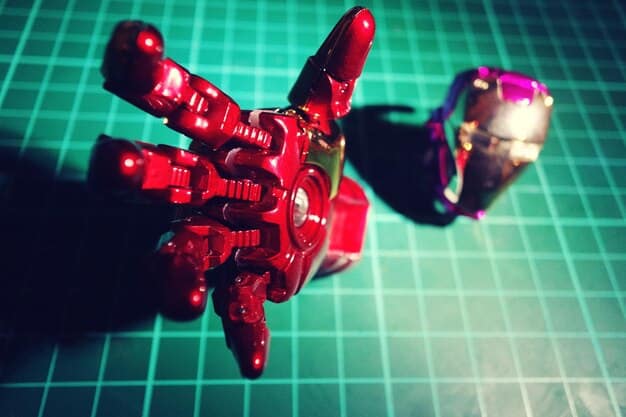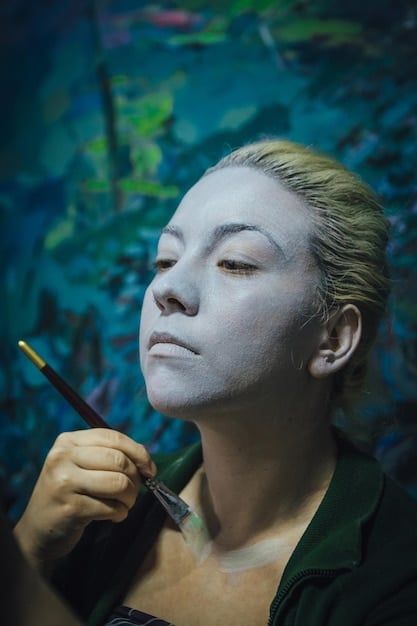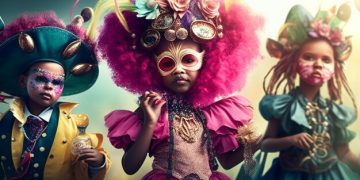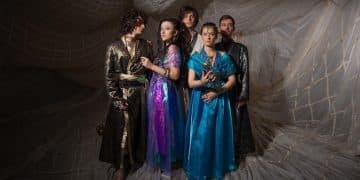The Ultimate Guide to Cosplay: Transform Yourself!

Cosplay involves transforming into beloved characters through detailed costumes and immersive performances, offering a creative outlet for self-expression and community engagement within the geek lifestyle.
Dive into the vibrant world of cosplay, where creativity meets craftsmanship. Whether you dream of embodying a superhero or recreating an iconic anime character, this guide will help you start with the basics.
What is Cosplay? A Beginner’s Introduction
At its core, cosplay is the act of dressing up as a character from a work of fiction. It’s about embodying the character not just in appearance, but in attitude and performance, too. It’s a fantastic way to express your passions and connect with other like-minded enthusiasts.
But what makes it so appealing, and why does it capture the imagination of so many?
The Appeal of Cosplay
Cosplay is about more than just wearing a costume; it’s an immersive experience that blurs the lines between fantasy and reality. Here are a few key reasons why cosplay is so captivating:
- Creativity and Self-Expression: Cosplay provides a platform to showcase your artistic talents through costume design, makeup, and prop creation.
- Community and Connection: Events connects you with others who share your interests, fostering friendships and a sense of belonging.
- Role-Playing and Performance: It’s an opportunity to step into the shoes of your favorite characters and bring them to life.
Many people begin their adventure due to these elements, attracted by the multiple possibilities that this world can provide.
Cosplay involves much more than dressing up; it’s about embodying the spirit of the character, showcasing creativity, and fostering a vibrant community.
Getting Started: Choosing Your First Character
Selecting a character can feel overwhelming with so many options from games, comics, TV and other forms of media. The main thing should be your personal choice and affinity for the character.
To make choosing much simpler, it’s beneficial to set some criteria to pick the perfect choice for you.
Factors to Consider When Choosing a Character
Here’s a framework to help you narrow the field:
- Personal Connection: Start with characters you admire, respect, or simply enjoy. Your enthusiasm will fuel your cosplay efforts.
- Skill Level: Choose a character whose costume complexity aligns with your current crafting abilities. Simpler designs are great for beginners.
- Budget: Factor in material costs, which can vary widely. Researching character designs and associated costs can help make a responsible decision.
- Comfort: Consider physical constraints, such as mobility and weather conditions. A heavy, elaborate costume might not be ideal for a summer convention.
Choosing a Cosplay to start with will be much more simple if you take all of these aspects into consideration.
Choosing the perfect character blends personal passion with practical feasibility, ensuring a smooth and enjoyable cosplay journey.

Essential Materials and Tools for Cosplay
The right materials and tools are essential for bringing your cosplay vision to life. Having the necessary material can be a game changer in the final product.
From fabrics to foam, here’s what you’ll need for most cosplay projects:
Core Supplies for Every Cosplayer
Here is a brief list of materials that you will need while starting your cosplay journey:
- Fabrics: Cotton, polyester, and spandex are versatile choices. Select fabrics based on the character’s clothing.
- Foam: EVA foam is popular for armor and props due to its lightweight and moldable nature.
- Adhesives: Contact cement, hot glue, and fabric glue are essential for bonding materials.
- Paints and Finishes: Acrylic paints and sealants add color and protect surfaces.
Besides the materials, it’s also important to have some basic tools to make the job easier.
Essential Tools for Cosplay Construction
These tools are important to any cosplayer during the assembly process. With these on your hands, you will be ready for anything:
- Cutting Tools: Scissors, craft knives, and rotary cutters for precise fabric and foam cuts.
- Sewing Machine: A sewing machine is handy for creating costumes.
- Heat Gun: Shapes and seals foam for creating armor and props.
- Sandpaper: Smooths rough edges on foam, wood, and plastic.
Having the right combination of materials and tools empowers cosplayers to create high-quality costumes and props.
Basic Sewing and Crafting Techniques
Mastering basic sewing and crafting techniques significantly enhances the quality and durability of your cosplay creations. Understanding them will give you a huge advantage.
Whether you’re a beginner or have some experience, these skills prove invaluable:
Essential Sewing Techniques
Having some sewing understanding can be very helpful:
- Hand Stitching: Learn basic stitches like the running stitch, backstitch, and whipstitch for attaching materials and adding details.
- Machine Sewing: Familiarize yourself with your machine. Practice straight seams, curves, and different stitch types.
- Pattern Making: Draft simple patterns from existing garments or use commercial patterns as a base.
Other than sewing, sometimes working with foam and sintra is necessary.
Fundamental Crafting Techniques
Having crafting skills helps with props and armor pieces:
- Foam Shaping: Cut, heat, and shape EVA foam to create armor pieces and props.
- Surface Finishing: Smooth surfaces using sandpaper, apply primer, and paint with acrylics.
- Detailing: Add details with craft foam, Worbla, or 3D-printed parts.
These techniques empower cosplayers to build intricate costumes and props, enabling them to accurately bring their favorite characters to life.

Perfecting Your Look: Makeup and Wig Styling
Makeup and wig styling are essential components in completing a polished cosplay look, helping embody the character’s distinct appearance. Getting those right will make you look much more like the source material.
They are used to bring character to life beyond just the costume.
Cosplay Makeup Essentials
Makeup techniques can give you the perfect look:
- Foundation and Contour: Match your foundation to your skin tone and use contouring to add definition and shape.
- Eye Makeup: Focus on recreating the character’s eye shape and color using eyeshadow, eyeliner, and mascara.
- Lip Color: Choose a lip color that complements the character’s overall aesthetic, whether it’s a natural shade or a bold hue.
Also, a wig that looks like the style of the character can be hard to get.
Wig Styling Techniques
Here are the steps for basic wig styling:
- Cutting and Layering: Trim the wig to the desired length and add layers using scissors or a razor.
- Styling with Heat: Use a heat gun or hair straightener to curl, straighten, or shape the fibers.
- Adding Volume: Tease or backcomb the roots to add volume and create dynamic shapes.
Effective makeup and wig styling turn a good costume into a flawless representation, perfectly embodying the character’s iconic look and enhancing the overall cosplay.
Showcasing Your Cosplay: Posing and Character Acting
Posing and character acting are essential skills for bringing your cosplay to life and capturing the essence of your chosen character. Making a good photo is more than just having a good looking costume.
The right pose can capture your essence and personality.
Effective Posing Techniques
Here are some things to consider while posing:
- Study Character Poses: Research iconic poses from the source material and practice replicating them in front of a mirror.
- Dynamic Composition: Experiment with different angles and stances to create visually interesting photos.
- Facial Expressions: Convey the character’s personality through appropriate facial expressions, whether fierce, playful, or stoic.
Posing is not everything, sometimes it’s important to also act like the character, this takes the cosplay to another level.
Character Acting Tips
These tips will help any cosplayer during conventions:
- Understand the Character: Dive deep into the character’s background, motivations, and mannerisms from their source material.
- Voice and Dialogue: Practice the character’s voice and memorize key phrases or lines to use when interacting with others.
- Body Language: Adopt the character’s posture, gait, and gestures to fully embody their persona.
Mastering posing and character acting transforms a great costume into a compelling performance, captivating and engaging audiences while authentically embodying the spirit of the character.
| Key Point | Brief Description |
|---|---|
| 🌟 Choosing a Character | Select a character you admire and whose costume matches your skills and budget. |
| 🧵 Essential Materials | Fabrics, EVA foam, adhesives, paints, and basic crafting tools are crucial for building your costume. |
| 🎨 Makeup & Wig Styling | Perfect your character’s look with makeup techniques and wig styling to enhance your cosplay. |
| 🎭 Posing & Acting | Study poses and mannerisms to fully embody your character and captivate your audience. |
FAQ
▼
The initial step is selecting a character that resonates with you and whose costume suits your skills and budget. This choice sets the foundation for your entire cosplay endeavor.
▼
Key materials include fabrics, EVA foam for armor, reliable adhesives, paints for detailing, and basic crafting tools to ensure precision in creating your costume and props.
▼
Makeup is crucial as it enhances your features to resemble the character. It involves contouring, eye makeup, and lip color to capture the character’s unique features effectively.
▼
Wigs are vital as they complete the look, matching the character’s hairstyle. Styling techniques like cutting, layering, and using heat tools are essential for achieving the desired appearance.
▼
Posing and acting bring your cosplay to life by embodying the character’s personality. Researching poses, mastering expressions, and understanding mannerisms enhance your performance.
Conclusion
Cosplay is a gateway to imagination and craftsmanship, enriching the fan experience and creating a strong community for those who wish to take part in this creative world.





